Your cart is currently empty!
How to Make a Square Based Slab Mug By Hand
Published:
Last Updated:
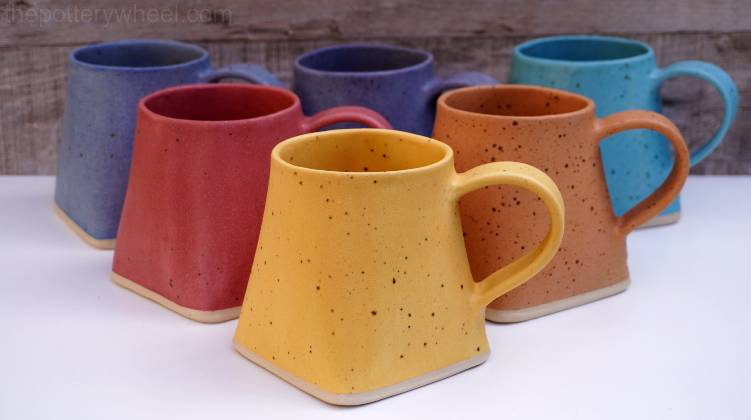
Affiliate Disclaimer
As an affiliate, we may earn a commission from qualifying purchases. We get commissions for purchases made through links on this website from Amazon and other third parties.
This step by step guide is an overview of how to make a square based slab mug by hand.
If you would like to give it a try, you can get a copy of the template in my Etsy store here…
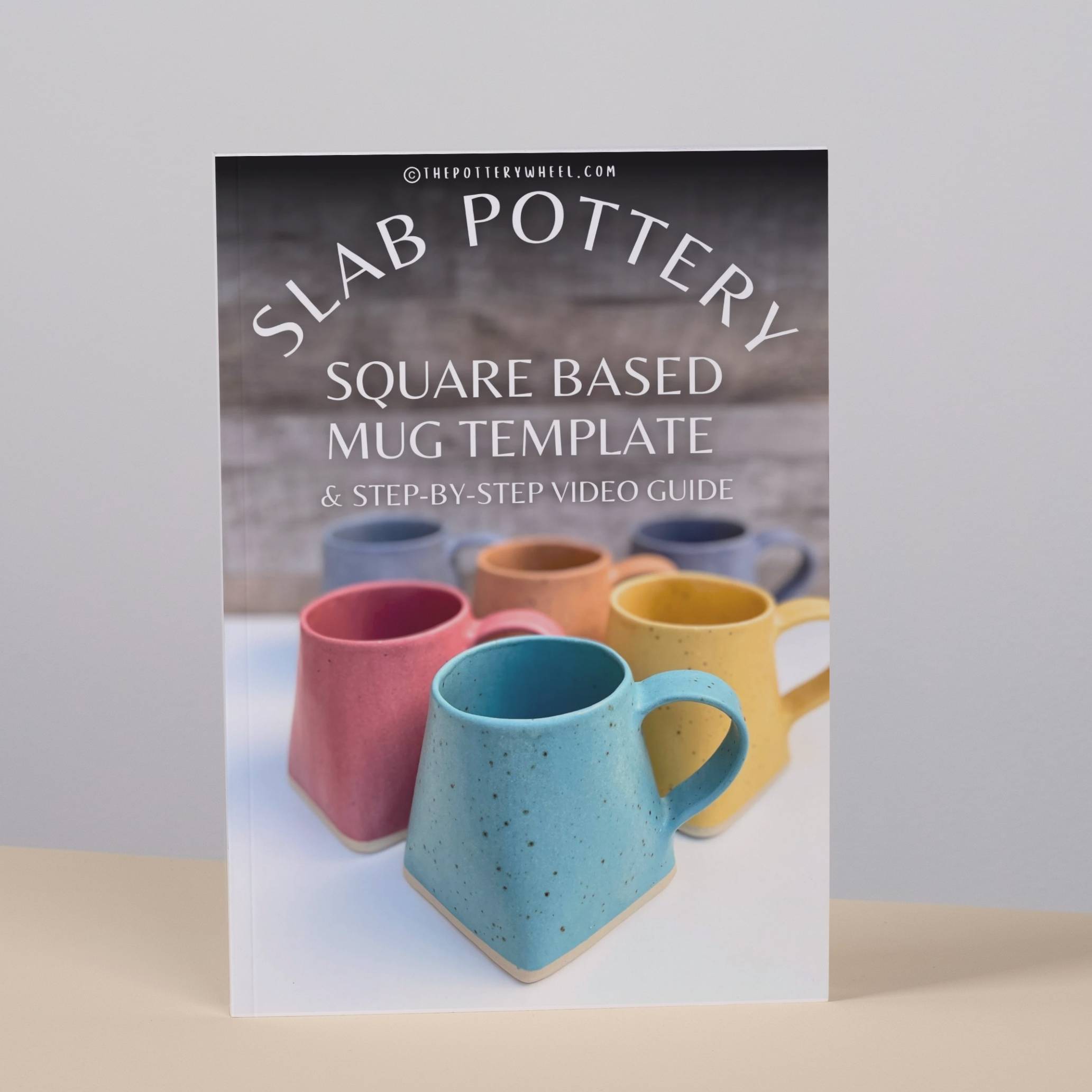
Get the Template Here
You can get a copy of this template (and my other slab pottery templates) from my Etsy store here
Making the Square Based Slab Pottery Mug
Here are some things that you might need if you want to make this project.
You can substitute a lot of things on the list for regular household items that you probably already have. For example, you can use an old kitchen fork instead of a clay scoring tool. Likewise, you can use an old knife from a dinner set as a clay knife too.
However, as you go along in your pottery journey it can help to gather a set of tools over time. These are the tools that I use for making the square bottomed slab mug…
Helpful Pottery Tools for This Project
- Clay
- A rolling pin with handles
- An extra wide rolling pin
- Canvas fabric
- Clay roller guides
- Platter tool
- Rubber pottery rib
- Serrated pottery rib
- Clay knife
- Craft foam
- Clay sponge
- Flexible chopping board
- Wooden pottery bat
- A banding wheel (Lazy Susan)
- Wooden modeling tools
- Letters for a makers mark
- Surform / clay shredder
- Chamois leather
Here are the steps you need to take to make these square based slab pottery mugs.
Step 1 – Making the Clay Slab
When I’m rolling clay, the first thing I do is flatten the clay with the heel of my hand. It makes it easier to begin the rolling process. I roll the clay on canvas that has been stretched over plywood. This makes a good non-stick surface for making slabs.
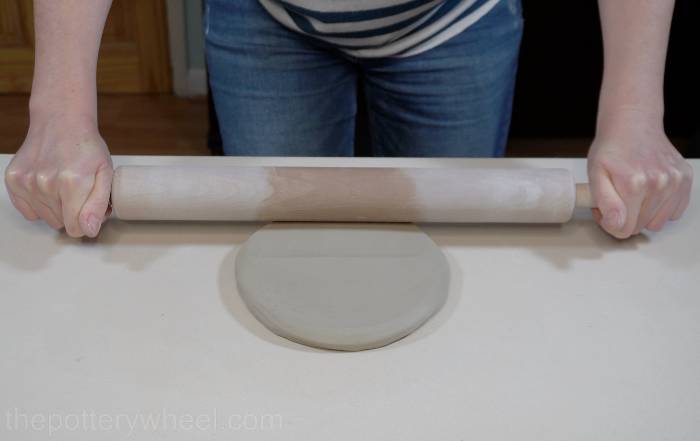
When rolling a slab of clay, it’s best to turn the slab over now and then and change the direction of rolling. This ensures you aren’t stretching the clay too much in one direction.
When the slab gets bigger and thinner, I start to roll it on a piece of loose fabric, as it’s easier to move the slab about and turn it over.
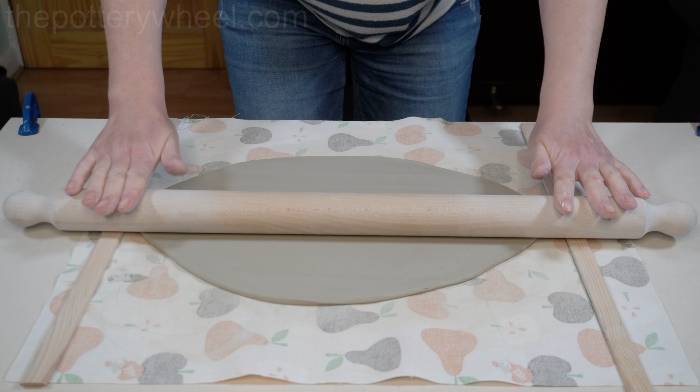
The wooden sticks on either side of the slab are 3 mm roller guides. They ensure that your slab is of an even thickness. You can get roller guides that are of different thicknesses. But I like 3mm for mugs as it makes the mug lighter.
To turn the slab over, I put another bit of fabric on top, slide my hand underneath, and flip it over. Then I peel the fabric off the top.
Having a wide rolling pin is helpful when working with bigger slabs. This rolling pin is a pasta roller which you can get here.
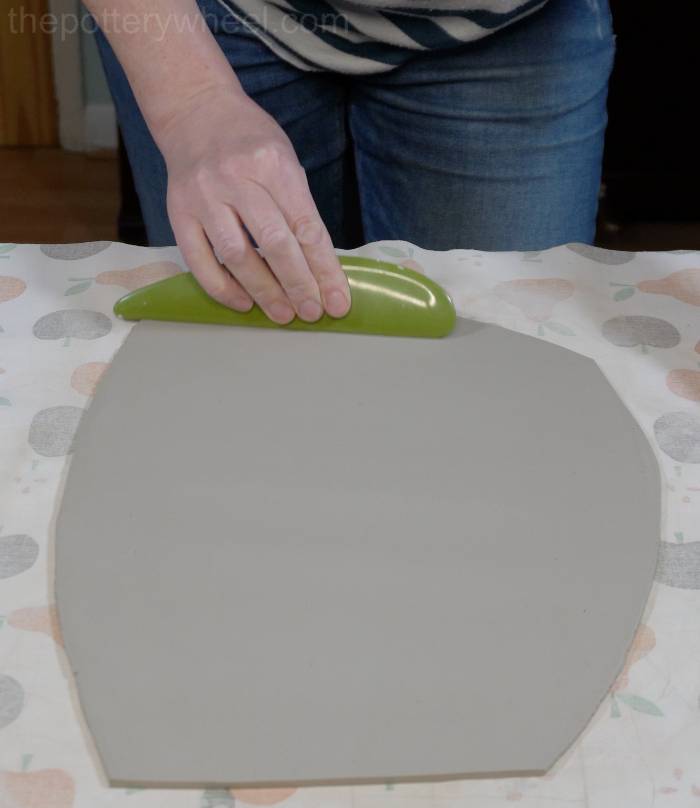
Once the slab is the right size, I run a platter tool over the surface. This gets rid of any texture on the clay left behind by the fabric, and it also helps to align the clay particles. You can use a regular pottery rib. I just like the platter tool because it’s nice and wide.
I turn the clay over and rib the other side too.
Step 2 – Cutting the Side of the Mug Using the Template
Once the clay is ready, I put the template in place. This is templates A & B that have been cut out and joined together to make the wall of the mug. You can also transfer the template design onto craft foam, which will last longer than a paper template.
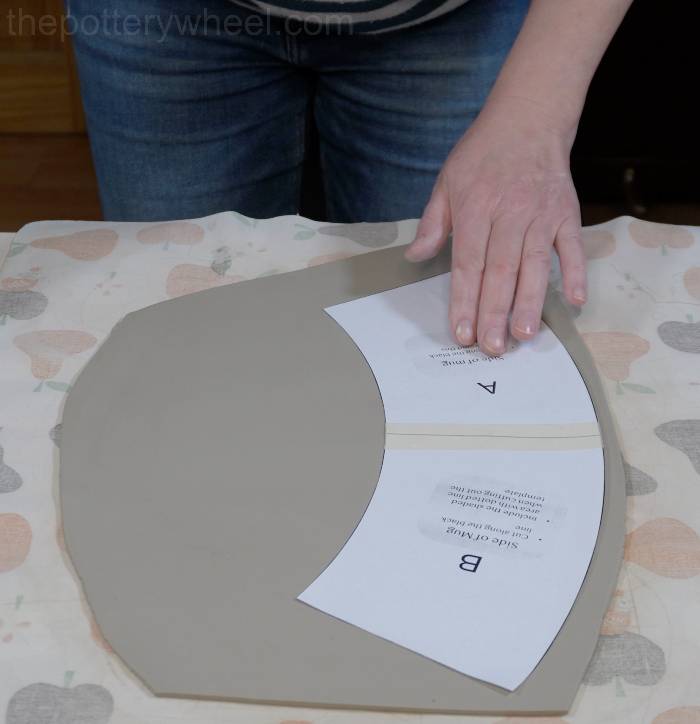
Any off-cuts of clay can be wedged and reused. But also it’s a good idea to keep any larger off-cuts of clay because you will need some clay slab to make the base of the mug too.
When I’m cutting along the curved edge of the slab I find it helpful to run both hands along the edge. I put my free hand on the paper template, that way my fingers don’t stick to the clay, but running my fingers up against the knife helps to steady the knife so I cut a nice smooth curve.
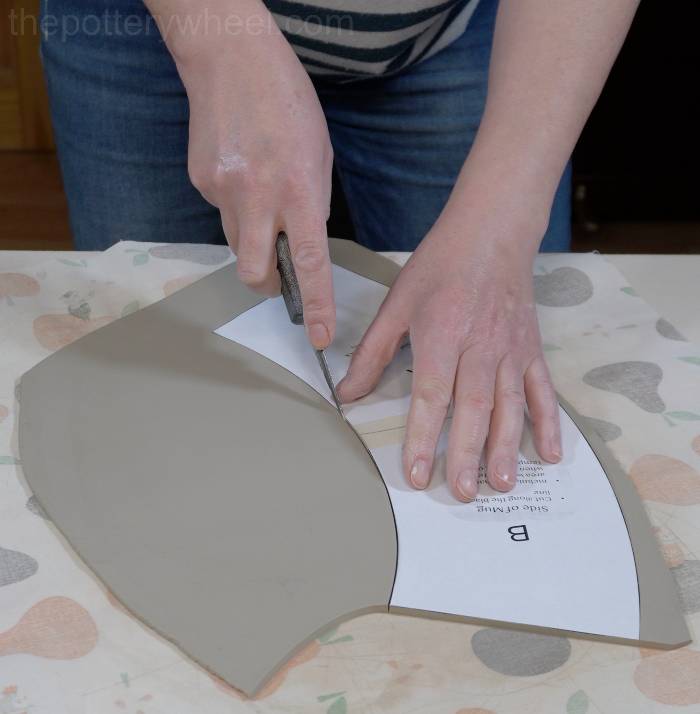
I peel away the template.
Then I run a damp sponge along the shorter curve. This edge is going to be the lip of the mug and it’s easier to smooth it off when the clay is flat. I turn the slab over and smooth the other side of the rim.
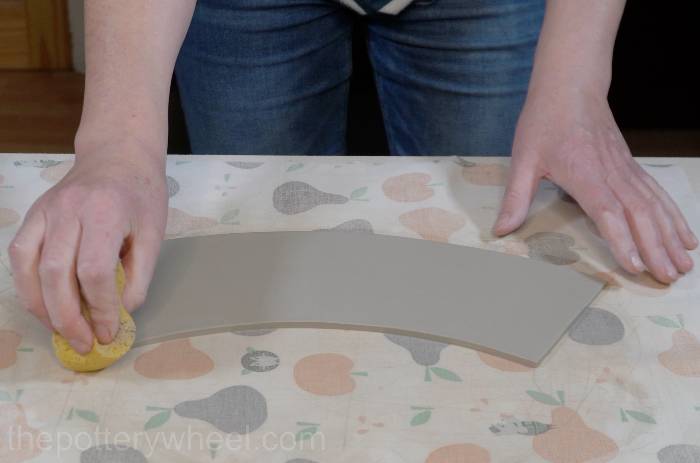
The clay is very soft now, so I need to put it to one side to let it firm up a little. I put a couple of sheets of paper on the clay and then put a flexible chopping board on top. I can then slide my hand under and flip the clay over. This way you can move the slab about without it stretching or losing shape.
I then get a wooden drying board and slide the slab off the chopping board onto the wood to let it firm up.
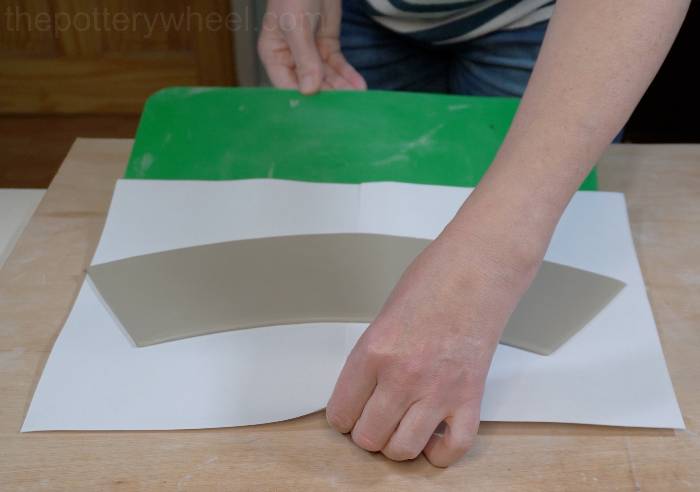
Step 3: Cutting Out the Base of the Mug Using the Template
In the meantime, I’m going to prepare the base of the mug. This is one of the off cuts of clay from earlier. I’m using template C. You can cut around template C using a straight edge, or you can do it freehand. Use your clay knife to cut around the curved edges and use your fingers to support the knife as you cut along the straight edges.
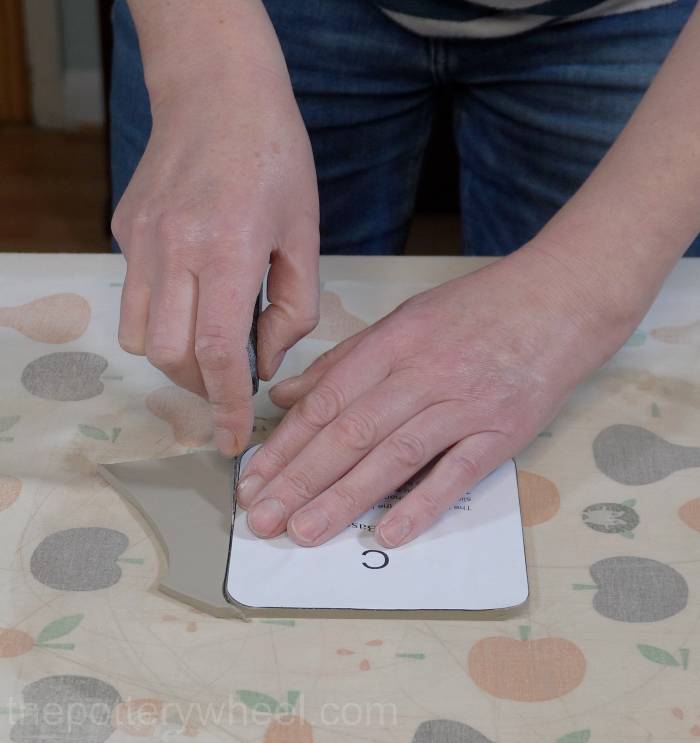
Once I’ve cut this out I need to put it to one side to let it firm up a little too. Lifting the slab with the paper template in place will give it a bit of support and stop the slab from stretching and losing its shape.
Step 4: Preparing the Handle for the Square Based Slab Mug
Now I make the handle using template D. Usually I use 6mm roller guides for the handle as I find a slightly thicker handle a bit more comfortable to hold.
I roll the clay and run the rib over both sides, then put the template in place.
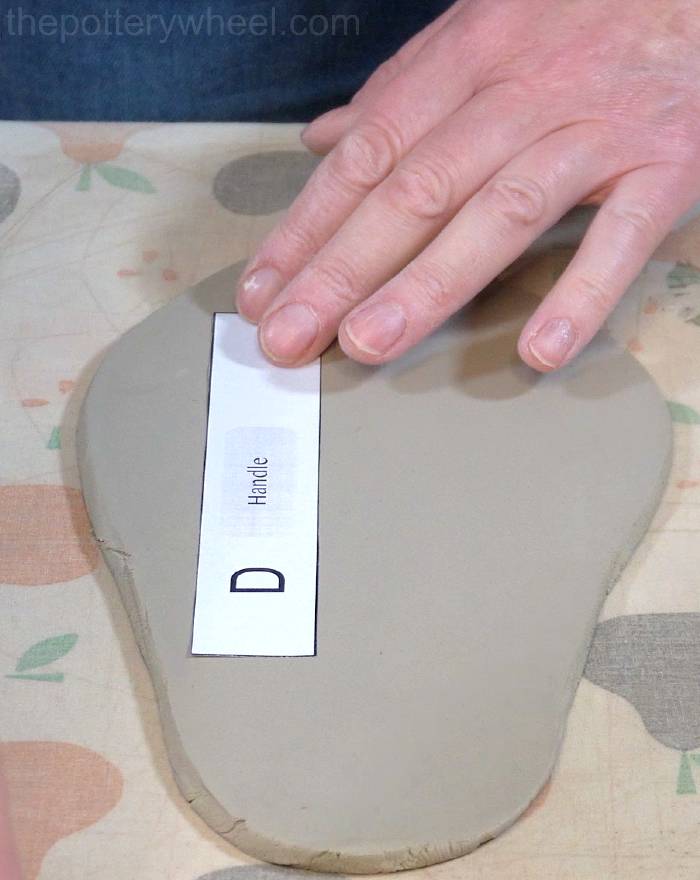
I cut along the sides of the template using a straight edge.
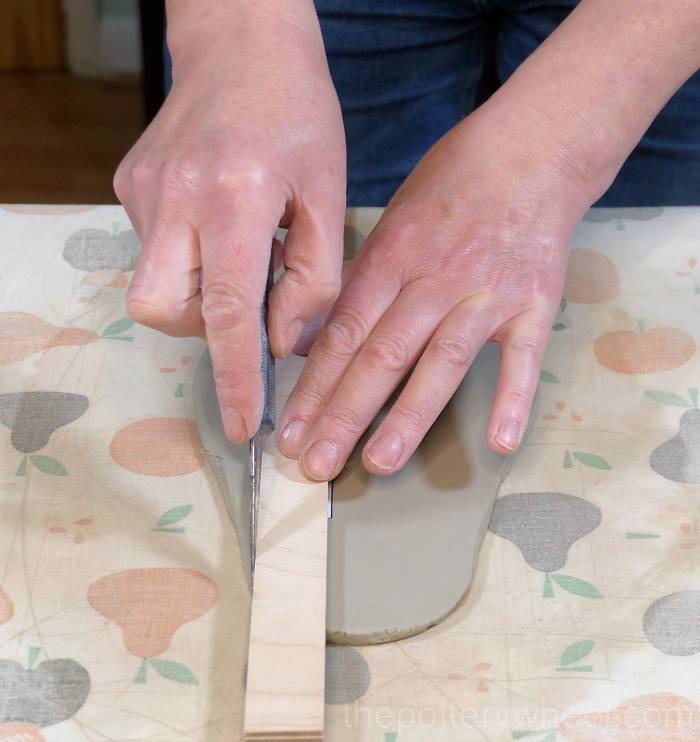
Then I smooth each edge of the handle as it’s much easier to do this when the handle is flat. I smooth the edges with a damp sponge and my fingers.
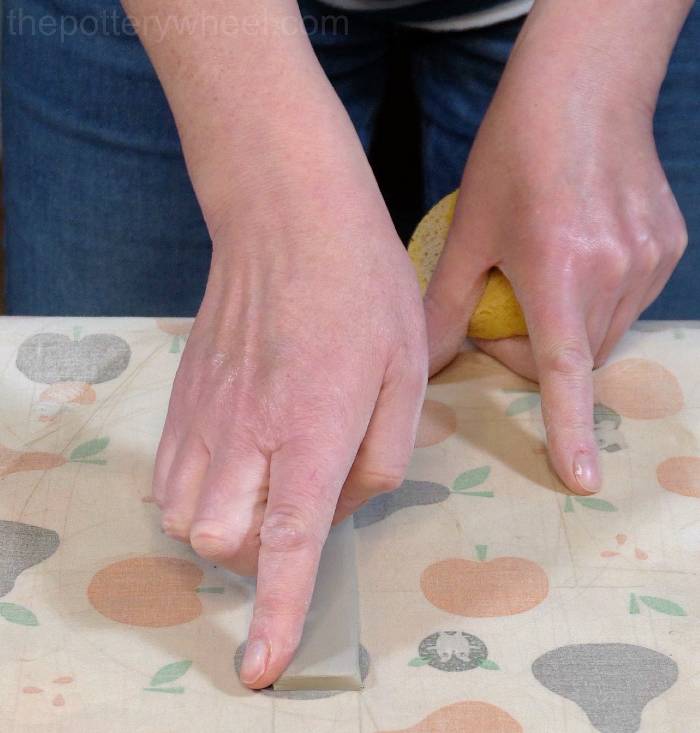
I then curve the handle round roughly into the shape that I want it to be and put it on a wareboard to firm up.
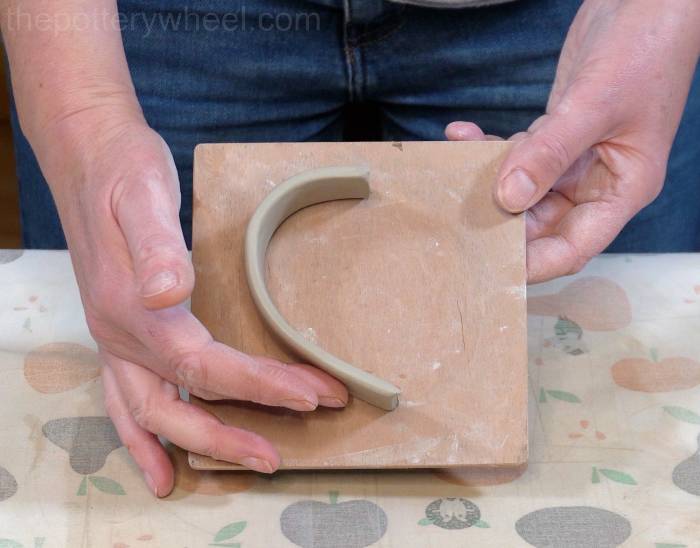
Step 5: Bevelling the Edges of the Slab
Once the big clay slab that makes up the wall of the mug is a bit firmer, I bevel both the short ends. Beveling means cutting at an angle. I do this so that when I join the two ends the clay overlaps and creates a better join.
I bevel the clay by holding my clay knife at a 45-degree angle and drawing it along the end of the slab.
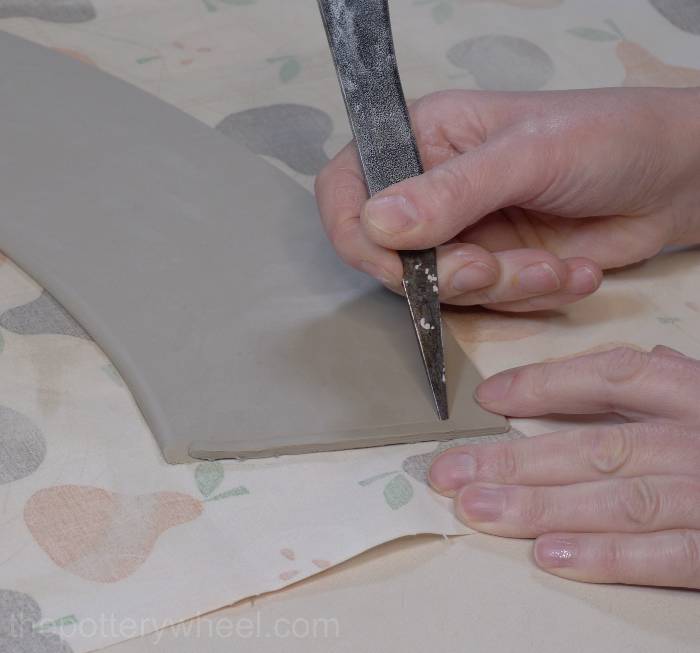
Important Tip!
It’s important to turn the slab over and bevel the other side in the same way. If you don’t turn the clay over the two beveled ends won’t overlap.
When the clay has been beveled, I score into the edges using my clay scoring tool. This creates a rough texture on the ends of the slab. I score in both directions to create a sort of cross-hatch texture.
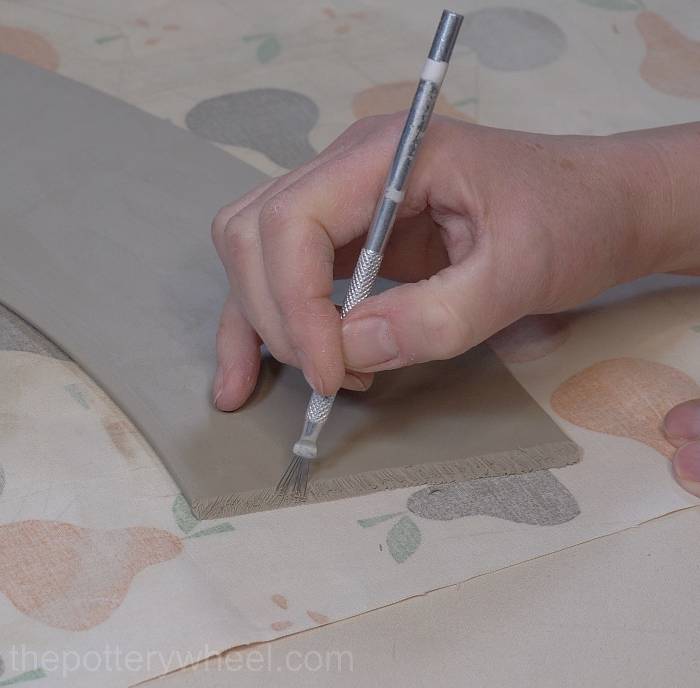
Step 6: Joining the Edges of the Clay Slab
Once both ends have been scored, I pick the slab up and curve it around. At this point, the clay is still soft enough to curve easily, but it can hold its own weight and it’s not so soft that it loses its shape.
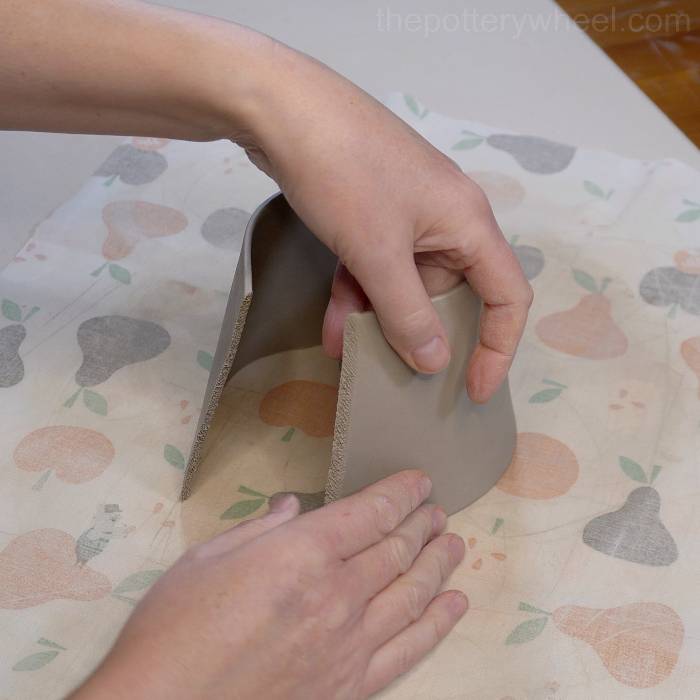
When the clay has been curved around into a cone shape, I apply slip to both scored edges. Slip is just clay dissolved in water. You can use regular slip, or you can also use plain water or vinegar.
I’m using something called magic water as I find it makes a good joint. It’s made from sodium silicate, soda ash, and water. Here is a guide on how to make magic water if you want to make some. But equally, regular clay slip is just fine.
I then line the two edges up and press them together. I squeeze the two seams together carefully, making sure to make a good bond.
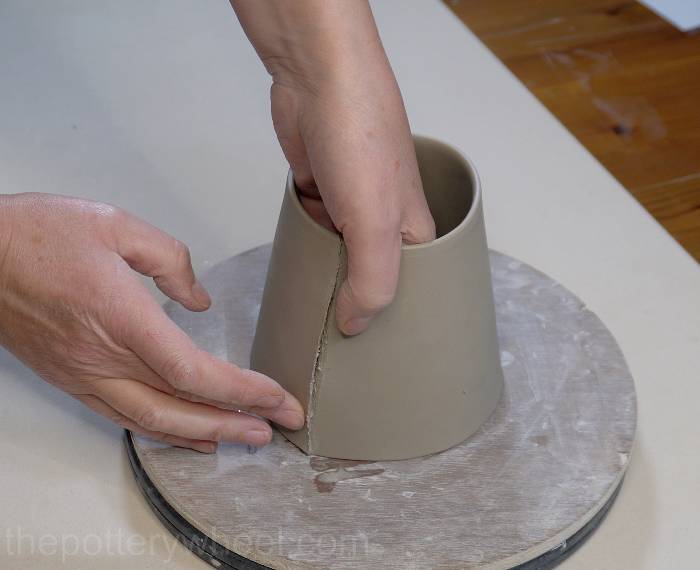
After I have pressed the seams together with my finger tips I run a rubber pottery rib over the join. This will wipe away any slip that has squeezed out from between the two edges.
But also, running the rib over the join a few times will smooth out the join and compress the edges together some more.
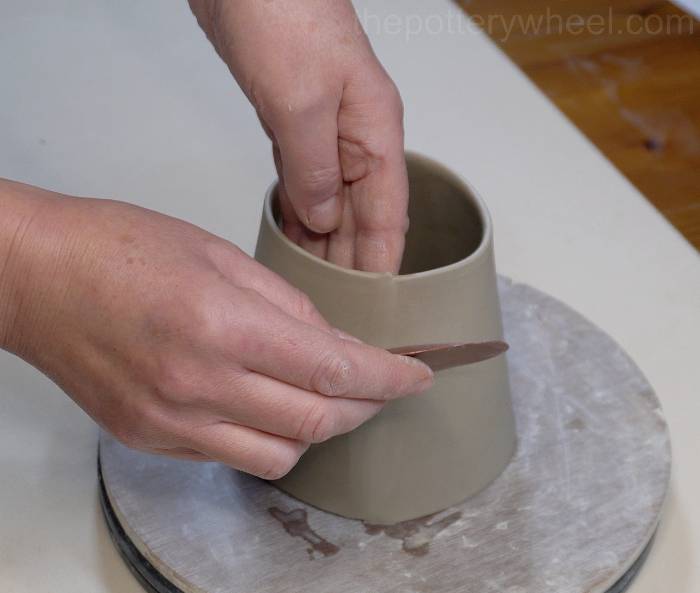
Once the outside surface of the join is smooth, I use a wooden tool to blend the inside surface of the join.
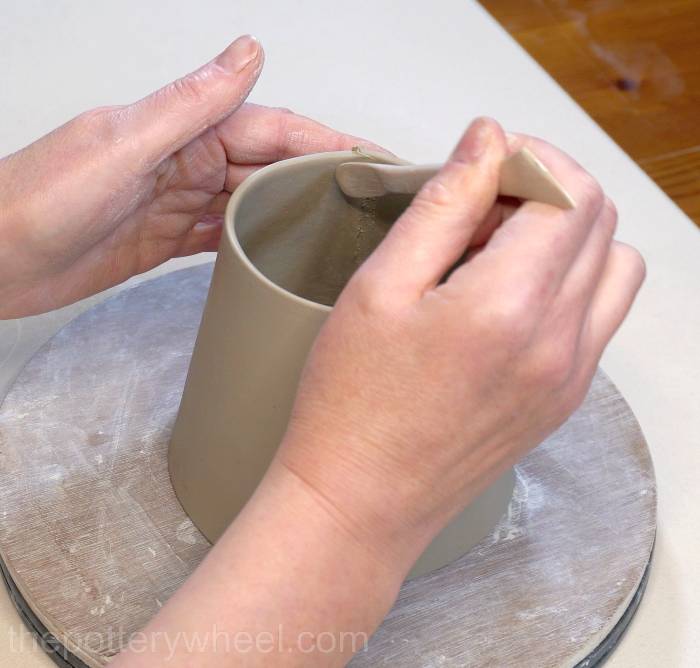
Using the wooden tool will probably leave some texture in the clay. So, I smooth this out using the platter tool. If you don’t have a platter tool you can use the smooth side of an old dessert spoon.
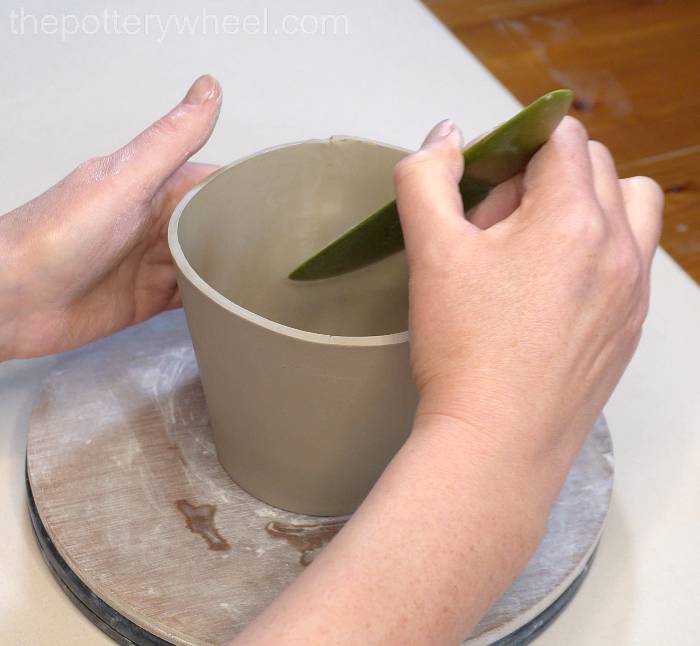
When the seam has been blended you might find that there is a small bump of clay either edge of the clay cone. You can trim this bump off with your clay knife and then smooth the edge of the clay.
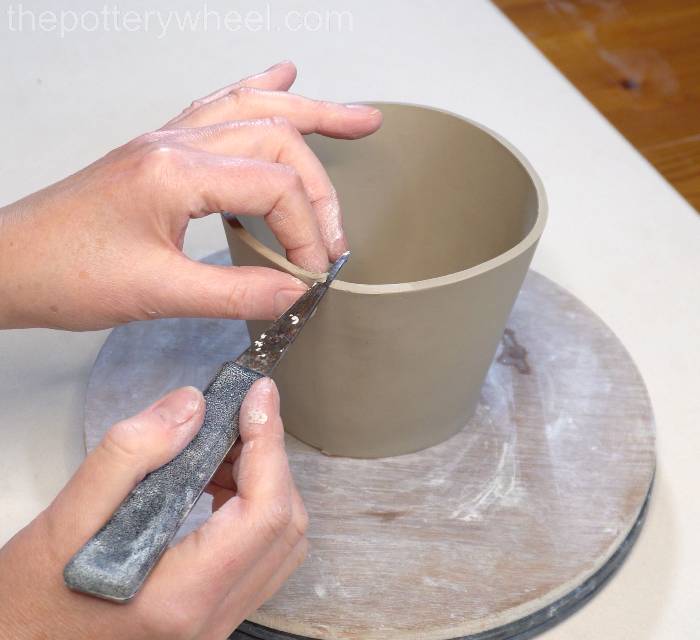
I then put the clay cone to one side to let the join bond together properly. To stop the clay from drying out too much, I cover it with a plastic bag. I also put an old plastic container in the tip rim of the mug to keep this nice and round.
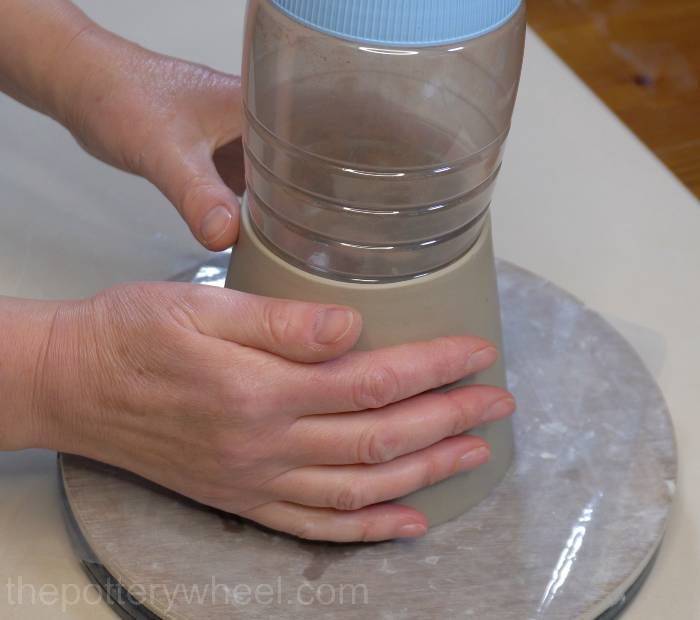
Step 7: Shaping the Square Based Slab Mug
The next step is to shape the bottom edge of the mug so that the clay cone has a square base. I’ve made a guide, shown in the picture below. It has a square with rounded corners on it. The square on the paper is designed to match the circumference of the bottom edge of the clay cone.
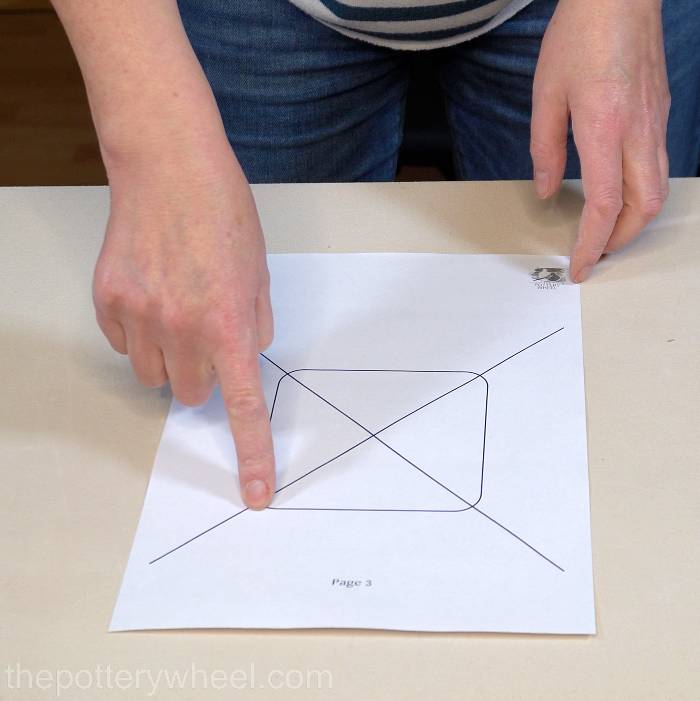
To shape the bottom of the cone, I line it up on the guide so that the point at which the two diagonal lines intersect is right in the middle of the mug. You can check that the mug is in the right position by looking over the top rim and adjusting the mug so it’s in the right place.

When the mug is in the middle of the guide, I start to squeeze the edge of the clay, and begin to form the corners of the square. I work my way around the square, gradually squeezing the corners to form the shape.
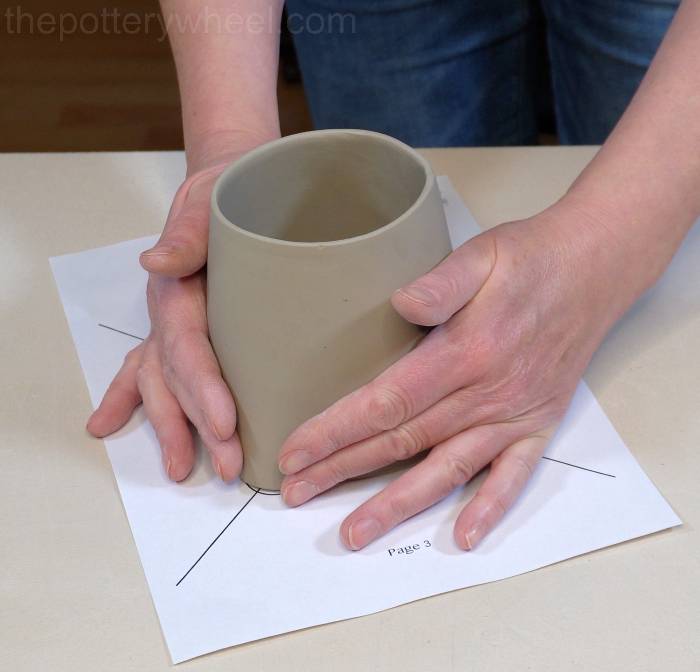
Once the corners have been formed, I work on straightening the edge of the sides.
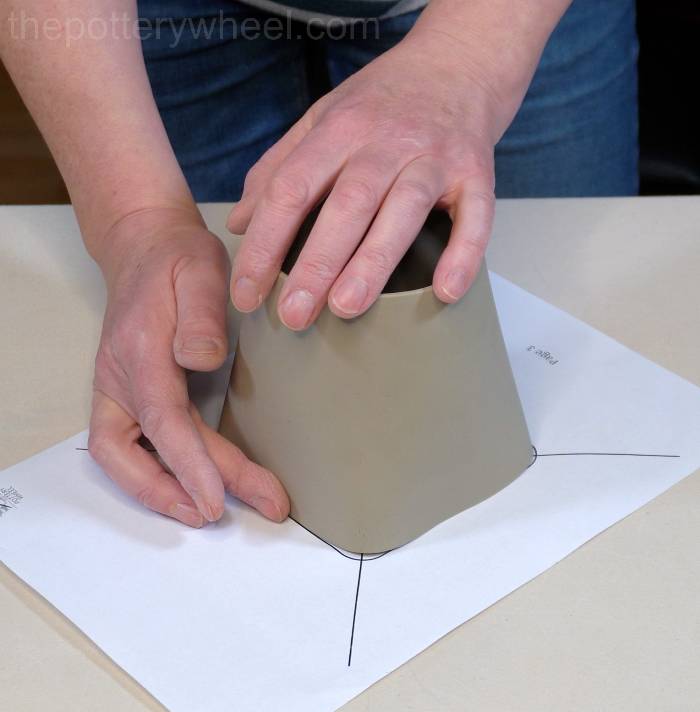
I straighten the edges using a combination of my fingers and also the straight edge of the platter tool. You can use a ruler or a straight piece of wood.
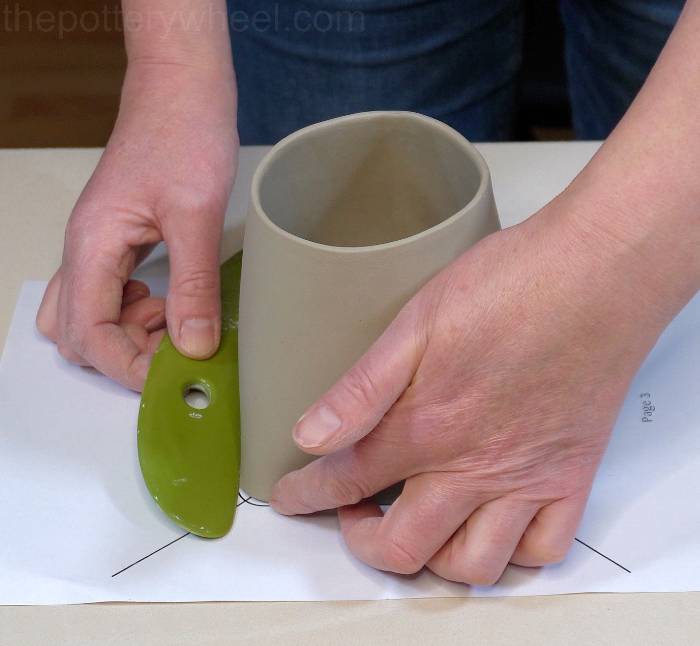
As you are shaping the base of the cone, you may find that fine cracks appear in the corner of the clay. Blend these in as you work. You can blend them in with the tips of your finger or with a slightly damp sponge.
Fine cracks don’t always form. It depends on how dry the clay has become. Ideally the clay needs to be soft leather hard.
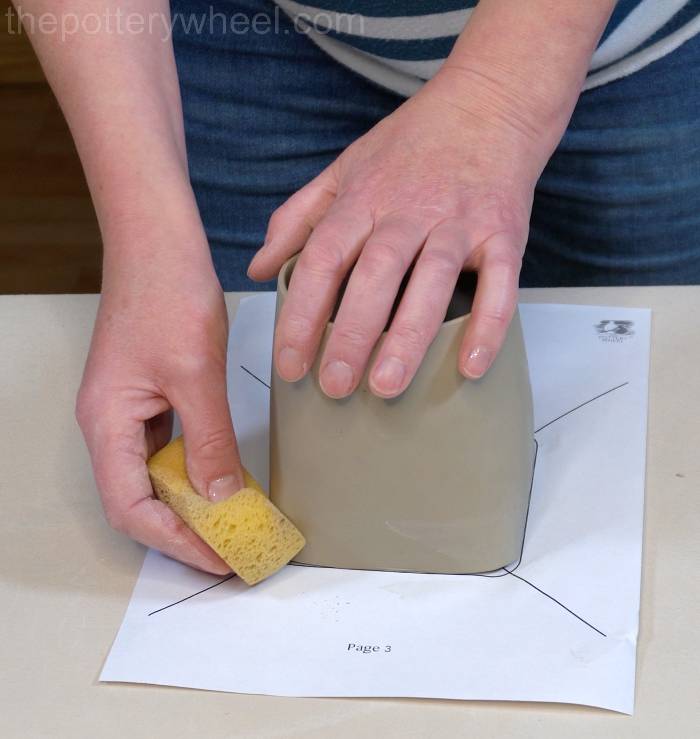
When the clay has been shaped, I put the old container in place again to keep the rim round. I then put the mug to one side, as the clay needs to firm up in its new square bottomed shape.
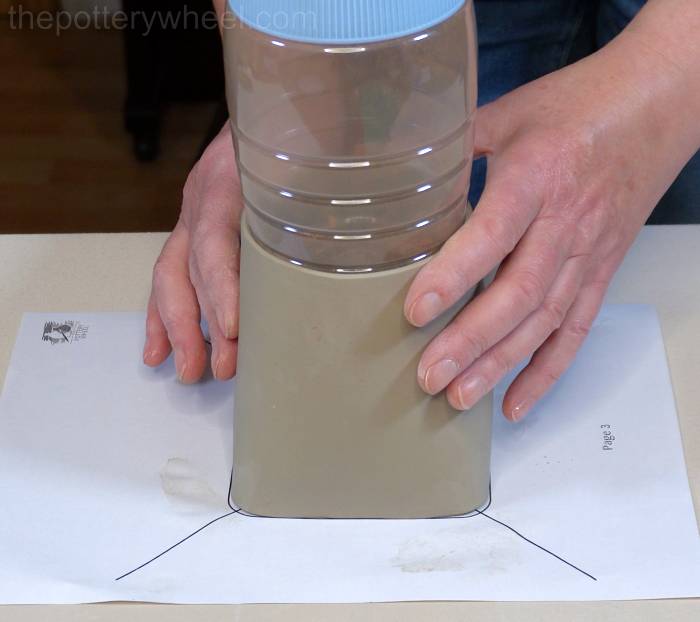
Step 8: Adding the Base to the Square Based Slab Mug
After the clay has become firmer, you need to add the base to the bottom of the mug. If you turn the mug over so that it’s sitting on the top rim, you will notice that bottom edge of the mug has slight curves on it. This is because the square shape was formed out of an arc shaped piece of clay.
In order for the bottom of the mug to fit well on the base, you need to get rid of the curve. One of the easiest ways to flatten the curve is to use a clay shredding tool. This is sometimes called a Surform.
Hold the mug in one hand, and carefully draw the clay shredding tool along the edge of the clay. This will flatten the curve and will allow the square base to sit flat on your work surface.
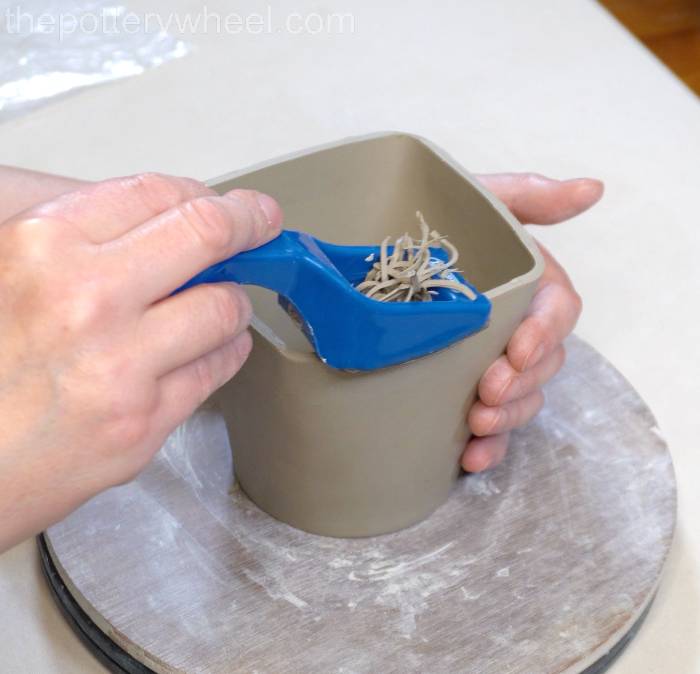
After flattening the base, I use my serrated rib tool to score into the bottom edge of the mug.
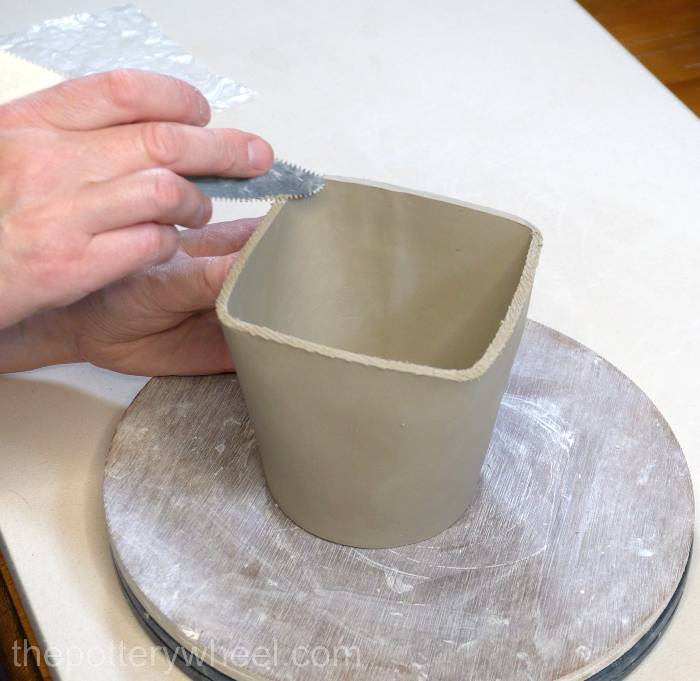
I also score along the edge of the base of the mug that I made earlier.
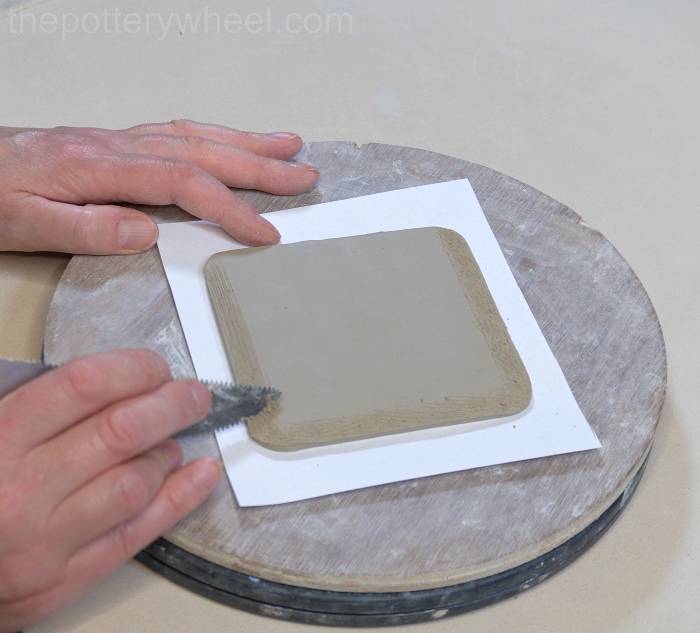
Apply clay slip to the bottom edge of the mug and also the scored base.
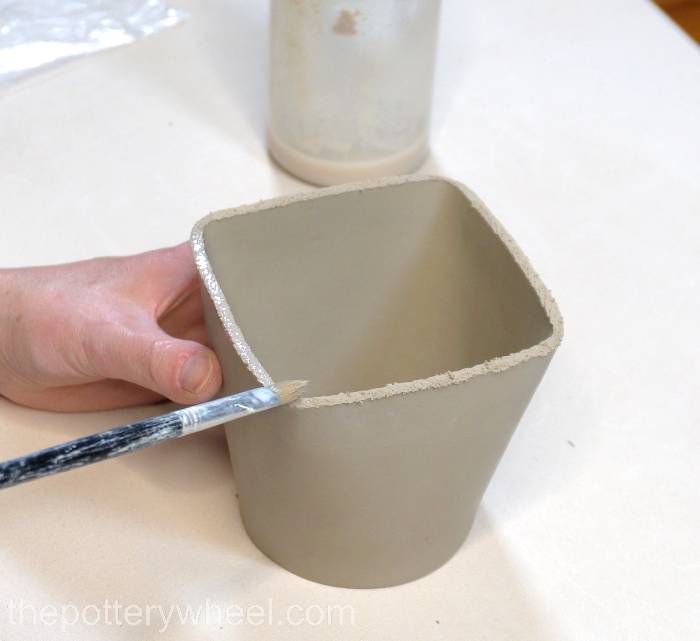
Then carefully lower the square bottom of the mug onto the base.
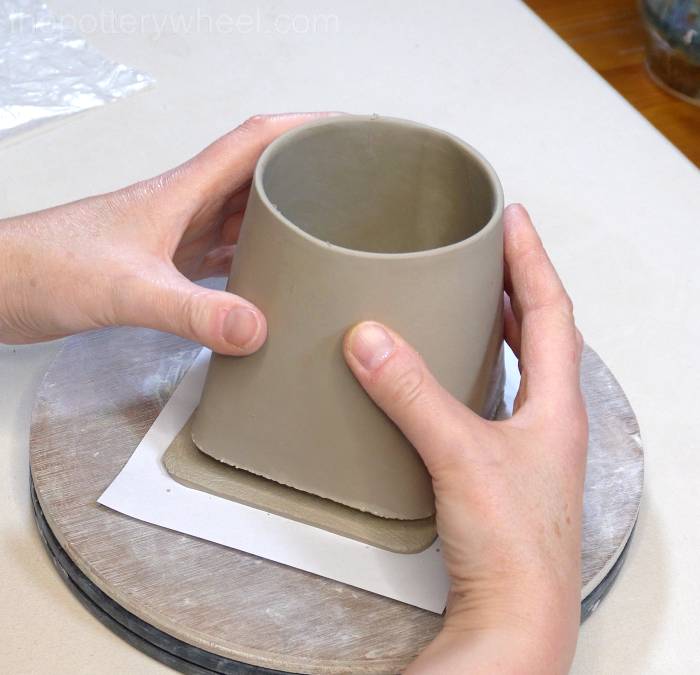
The base is made to be a bit bigger than the bottom of the mug. This gives you some margin for error, and it also gives you some clay to blend into the bottom edge of the mug, so that the base stays on.
I trim the base of the mug, so that there is about 1mm extra clay around the bottom of the mug.
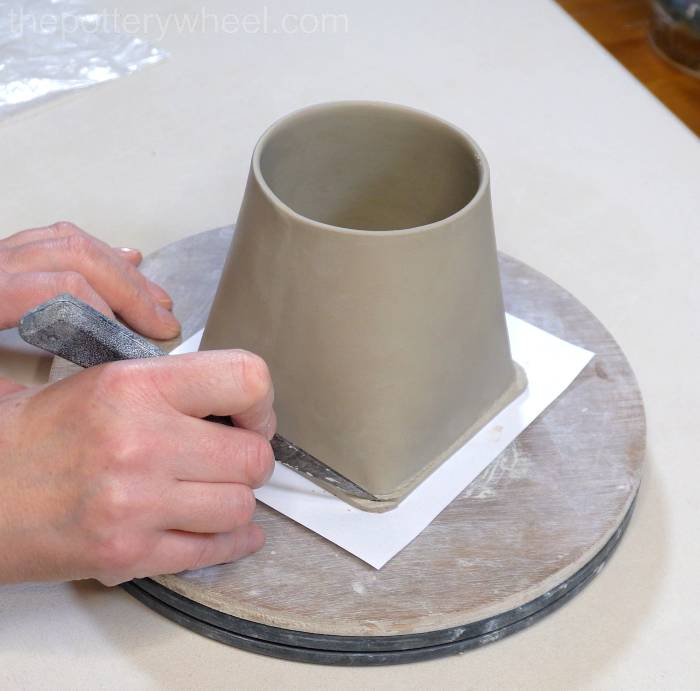
When the clay has been trimmed so that there is a 1mm margin, I use a wooden modeling tool to blend the extra clay onto the bottom edge of the mug. It’s important to blend this clay well so that the base of the mug doesn’t separate from the square bottom as the clay dries.
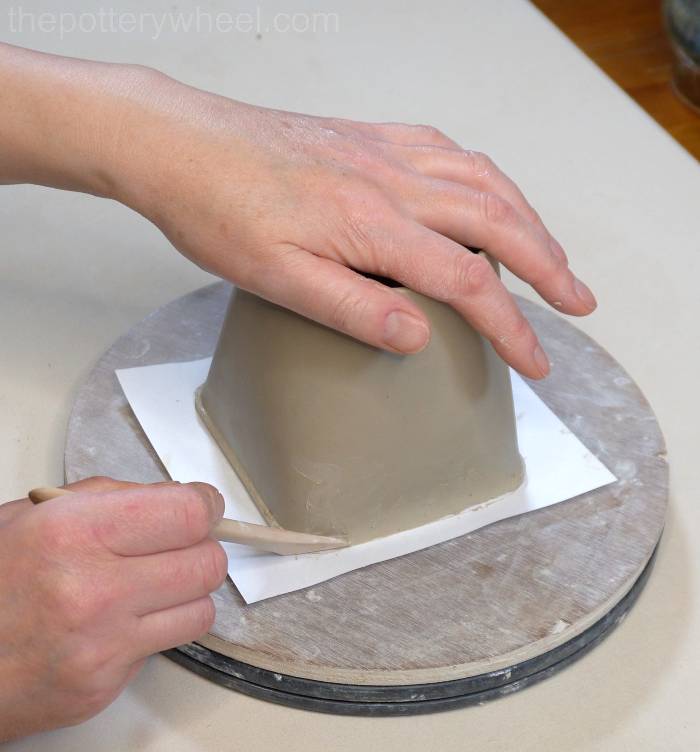
The wooden modeling tool will leave some marks behind on the surface of the clay. I use my rubber rib to smooth away any texture.
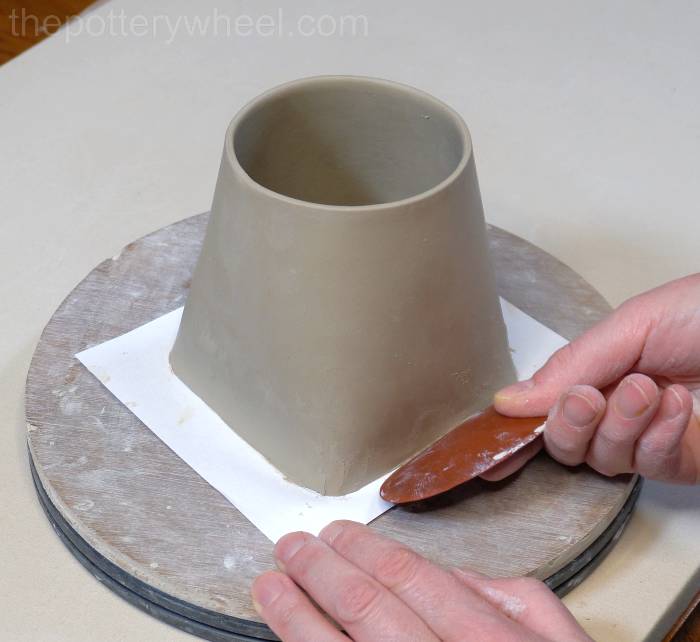
Step 9: Tidying Up the Base of the Square Based Slab Mug
I start tidying up the base of the square based slab mug but running the tip of a wooden modeling tool around the bottom edge. This cleans up a bit of excess clay and starts to form a slightly beveled edge along the bottom.
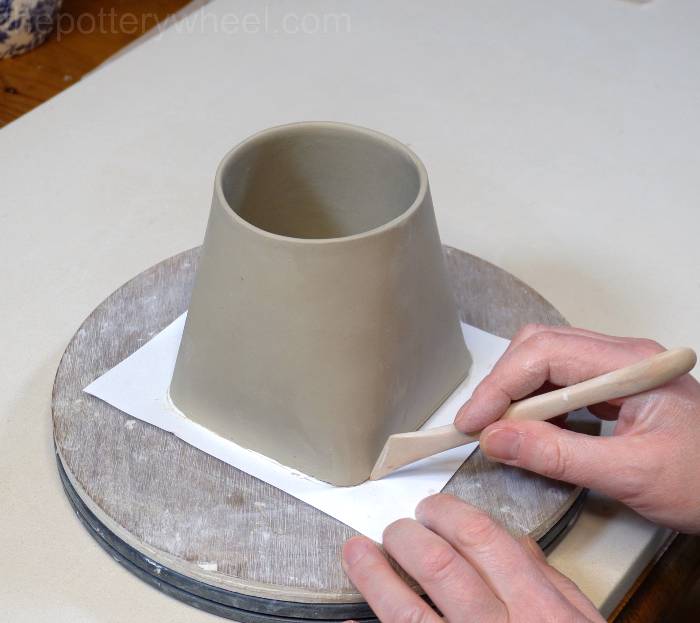
I then turn the mug over and use the flat edge of a modeling tool to tidy up the edge. It’s best to avoid having sharp edges on functional pottery, as they tend to chip easily when the mug is being used.
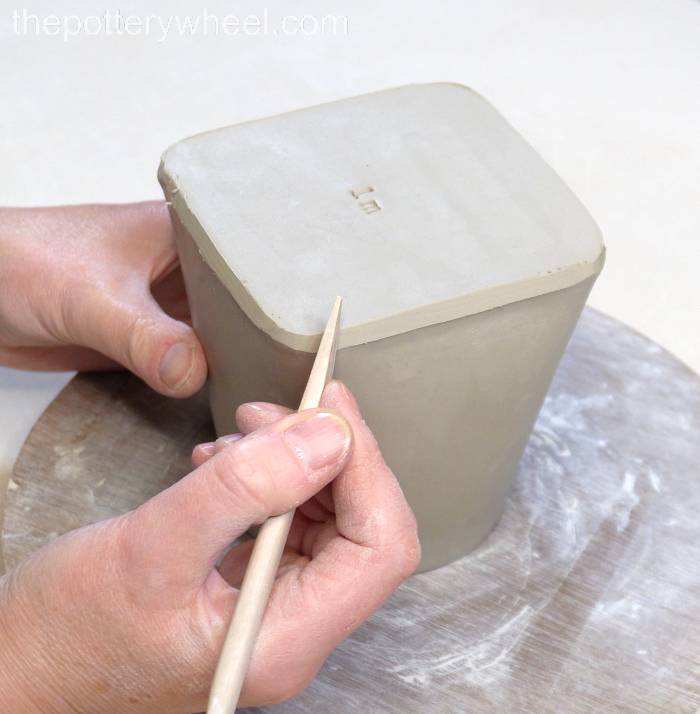
I soften the edges further using a damp chamois leather. The damp chamois leather will get rid of any marks made by the wooden pottery tools. But also they give the base a nice smooth rounded finish.
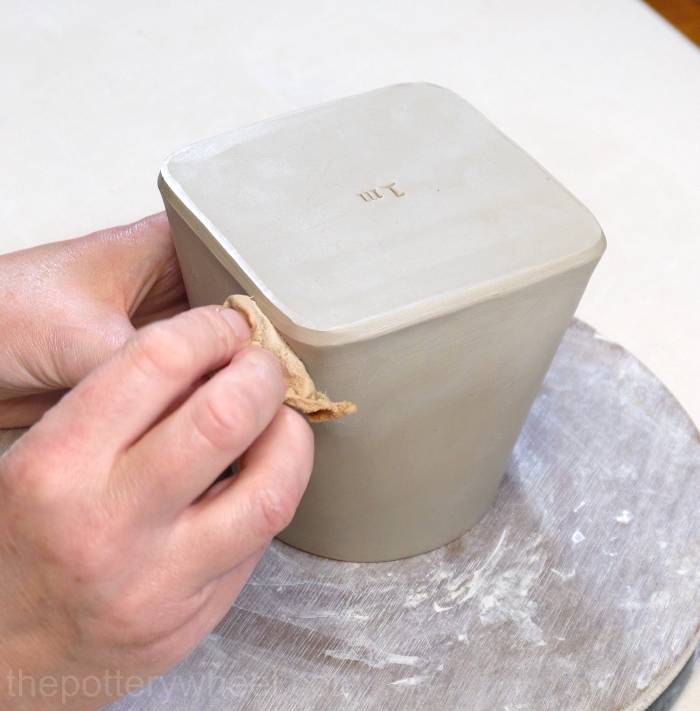
The last stage in joining the base to the mug is to run a soft brush along the inside join. I wet the brush with clay slip and then I run it over the join. This helps to get rid of any texture left behind on the inside of the mug.
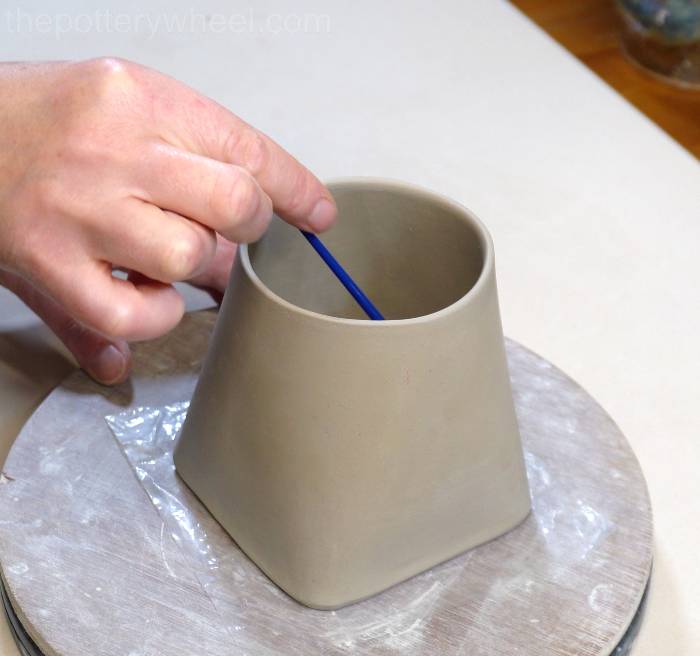
Step 10: Adding the Handle to the Slab Mug
When the handle that you made earlier is soft leather hard, it can be attached to the mug. There are lots of different ways to attach handles to mugs. This is just one of the ways that I like to do it.
I hold the handle in my hand as if I was holding a mug. And I mark where I want to trim the handle with the thumbnail of my other hand.
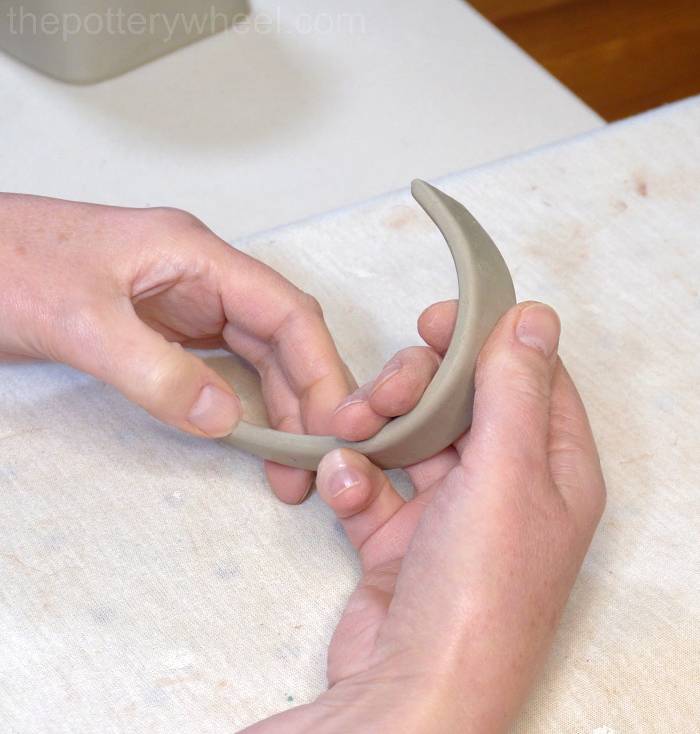
Then I cut the handle with my clay knife at the points where I made the marks with my thumbnail.
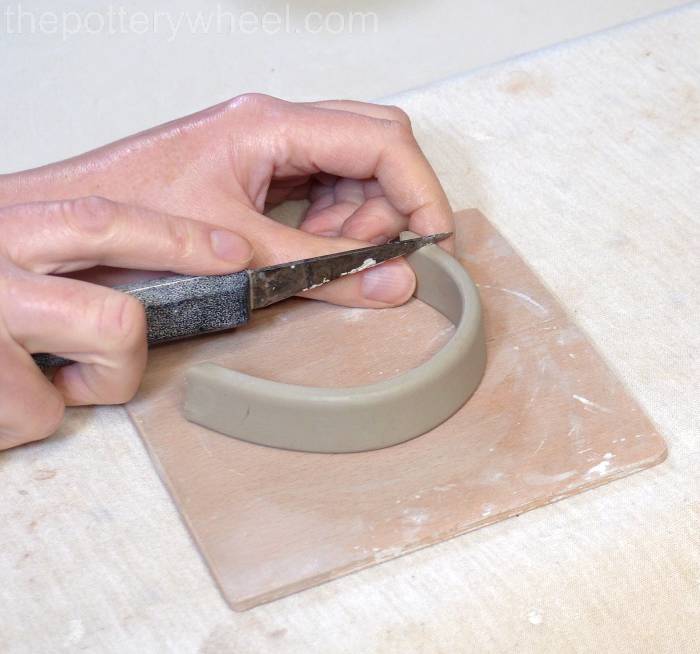
Hold the handle up against the mug and decide where you want it to be positioned. With the square bottomed slab mug, I like to add the handle on a corner, but you could add it to a flat side too.
When I’m happy with the position of the handle, I make some small marks in the clay where the handle is going to be attached.
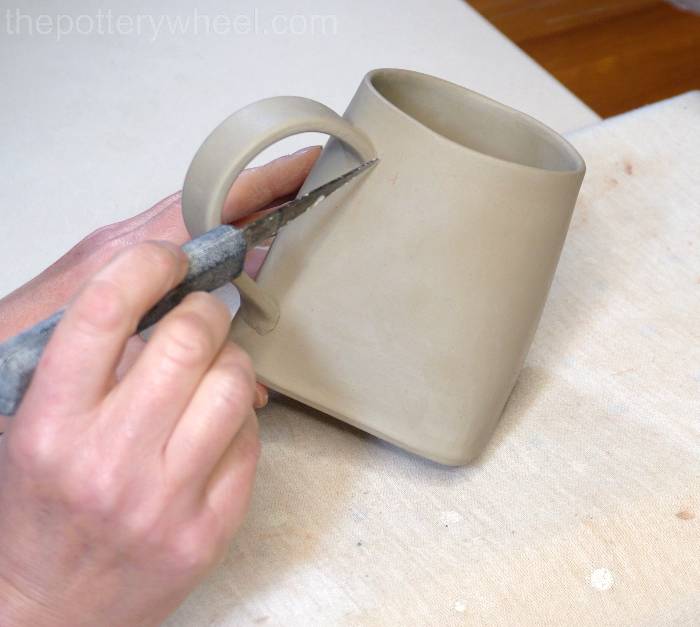
Using my serrated rib tool I score into the surface of the mug where the handle will be added. I also score the two ends of the handle and then apply a generous amount of slip to each of the scored surfaces.
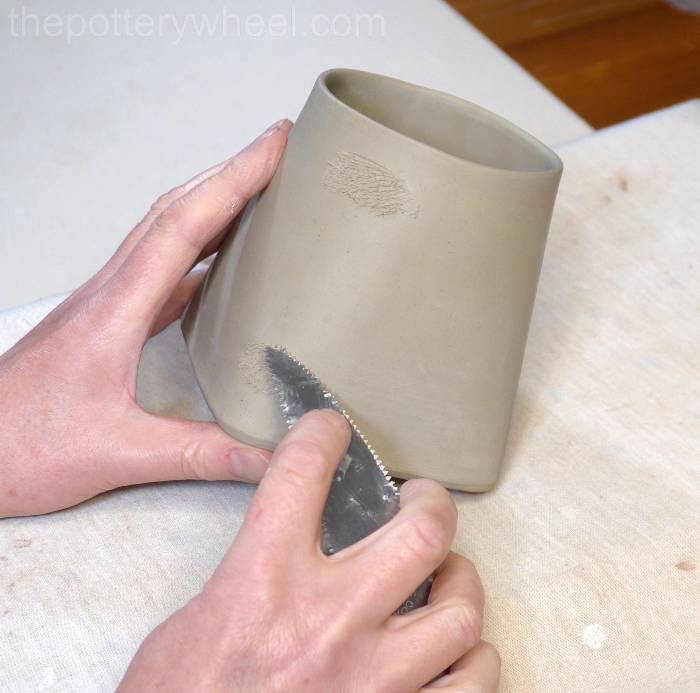
Press both ends of the handle into place on the mug. It can help to give the handle a bit of a wiggle so that the two scored surfaces start to grip on to each other. Use your free hand to support the inside of the mug so that it doesn’t lose its shape.
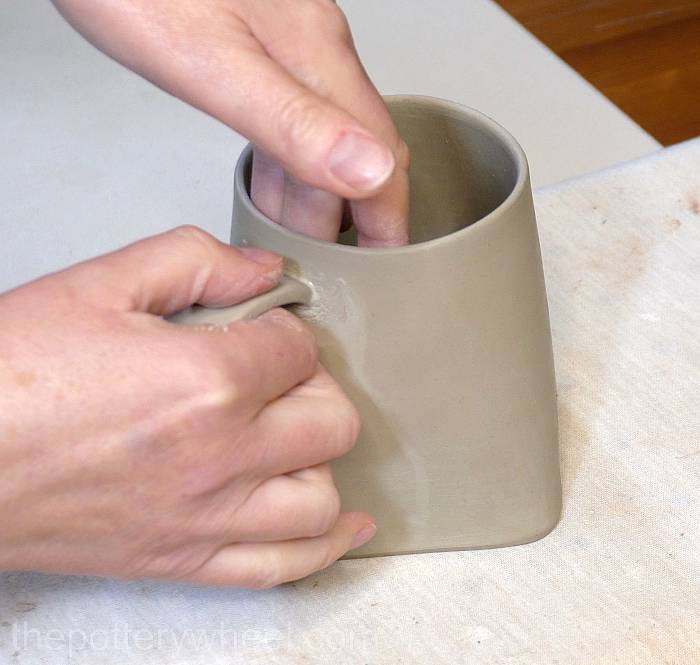
To make sure that the handle is securely attached, I wrap a thin coil of clay around the freshly made join. I then use a fine modeling tool to blend the clay coil into the join.
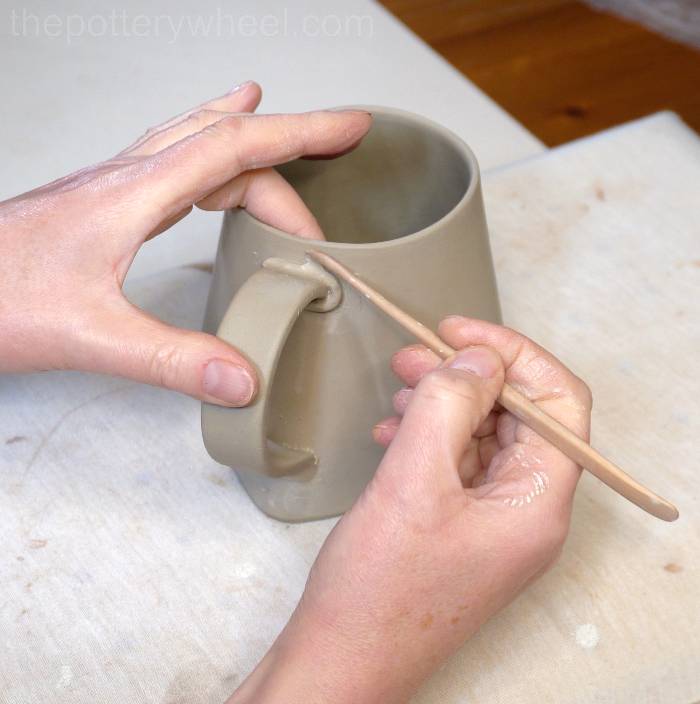
The modeling tool will leave some marks on the clay. I use my damp chamois leather to wipe away any texture on the surface, and create a nice clean smooth finish.
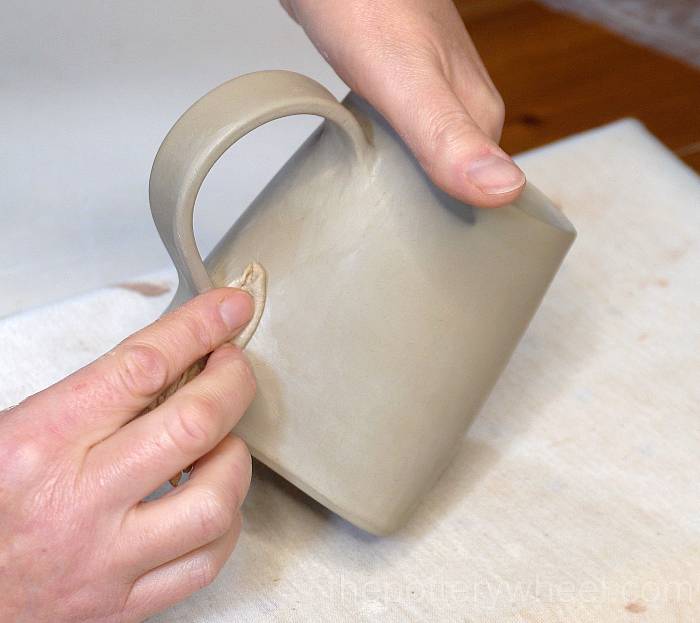
Step 11: Drying the Square Based Slab Mug
The mug is now ready to be dried before it is bisque fired and then glazed. Here are two top tips on drying the mug:
Tips on Drying The Mug
- When the clay is still leather hard, paint some wax resist on the handle and around the handle join. This will stop the handle cracking when the clay dries.
- Dry the mug slowly and evenly
- Put the plastic container in the rim as the clay dries to keep the rim nice and round. Remove the container regularly and reposition it. As the clay dries it will shrink. If it shrinks around the container the clay may crack. You can avoid this by removing the container at least once a day to make sure it’s not getting stuck.
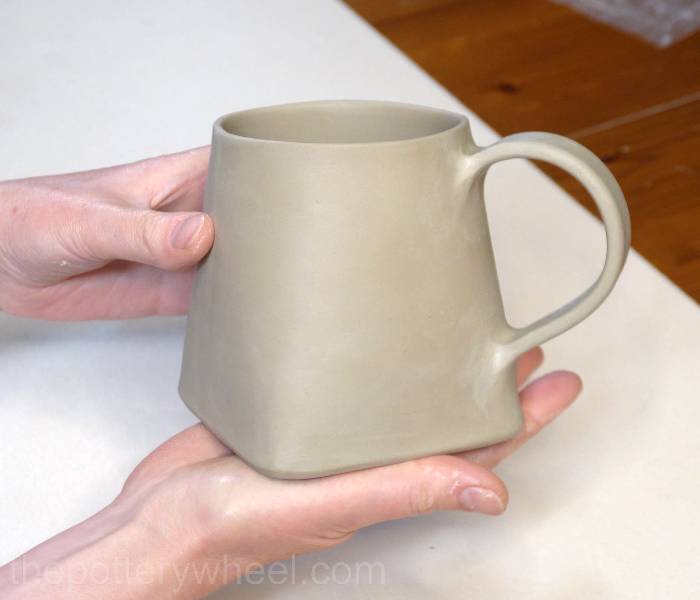
The Finished Slab Mug
Here is a set of the mugs I made using the square based slab mug template.
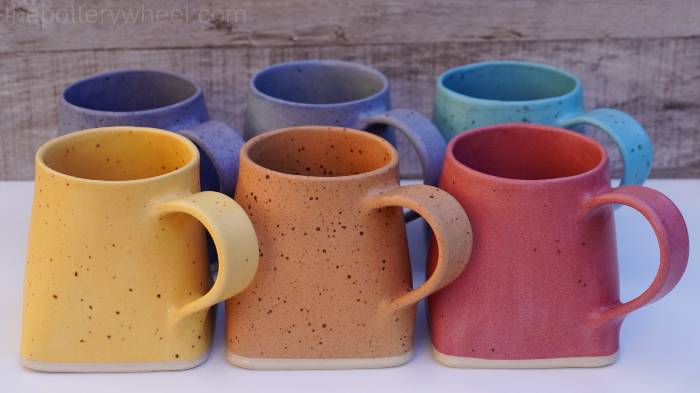
You can get a copy of the template in my Etsy store here…

Get the Template Here
You can get a copy of this template (and my other slab pottery templates) from my Etsy store here




Leave a Reply